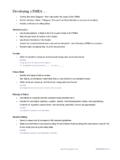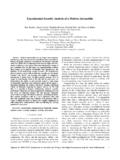Transcription of The Philosophy of TQM An Overview - The Quality …
1 1 Eng. 401: total Quality ManagementCourse Notes: TQM Philosophy -An OverviewHammettU. of MichiganThe Philosophy of TQM An OverviewReferences for Lecture:Background Reference Material on Web: The Philosophy of TQM by Pat HammettTQM = Customer-Driven Quality ManagementCustomer Quality MeasuresCustomers typically relate Quality to:1)Feature-based measures ( have or have not )ndetermined by designndiamond example: marquise shape diamond vs. round diamond2) Performance measures ( range of values )nconformance to design or ideal valuendiamond example: 4Cs --carat, clarity, color, cutIn this class, we will focus more on analyzing performance 401: total Quality ManagementCourse Notes: TQM Philosophy -An OverviewHammettU.
2 Of MichiganWhat are the Different Views of Quality ?nCustomer s View (more subjective view): nquality of the design (look, feel, and function).nconsider both feature and performance measures to assess valuenValue = Quality / Price (value determined by individual customers)nProducer s View (more objective view):nconformance to requirements (term coined by Philip Crosby). , # of defects per million products is a measure of of Quality (prevention, appraisal, scrap & warranty costs).nprevention costs: training, writing Quality proceduresnappraisal costs: inspecting and measuring product characteristicsnscrap and rework costs: internal costs of defective productsnwarranty costs: external costs for product failures in the fieldnincreasing Quality conformance reduces product costs and raises of Quality Paradigms (producer / customer relationship)nCustomer-craft Quality paradigm: ndesign and build each product for a knows the customer production and inspection Quality paradigm.
3 Nfocus on designing and building products for mass consumption. npush products on the customer (limit customer choices).nquality is maintained by inspecting and detectingbad innovation to this paradigm: statistical process control nTQM or Customer-Driven Quality paradigm:npotential customers determine what to design and Quality obtained by focusing on preventingproblems and continuously reducing variability in all organizational 401: total Quality ManagementCourse Notes: TQM Philosophy -An OverviewHammettU.
4 Of MichiganThe Quality Hierarchy (Evolution)1. Inspection2. Quality Control(QC)3. Quality Assurance (QA)4. total QualityManagementinspect &Fixing Mistakes(REACTIVE)operational techniques to make inspection more efficient & to reducethe costs of Quality . (example: SPC)planned and systematic actions toinsure that products or services conform to company requirements(example: reliability analysis). incorporates QC/QA activities intoa company-wide system aimed atsatisfying the customer.(involves all organizational functions)Preventionstop problems at source; greaterdesign emphasis(PROACTIVE)TQM DefinedTQM is a management Philosophy which seeks to integrate all organizational functions (marketing, finance, design, engineering, production, customer service.)
5 To focus on meeting customer needs and organizational objectives. It views organizations as a collection of processes. It maintains that organizations must strive to continuously improve these processes by incorporating the knowledge and experiences of workers. 4 Eng. 401: total Quality ManagementCourse Notes: TQM Philosophy -An OverviewHammettU. of MichiganThe Simple Objective of TQM Do the right things, right the first time, every time. Some Basic Tenets of customerdetermines Quality requires the establishment of effective Quality metrics.
6 We must speak with data not just within systemscreate Quality . is a moving target. It requires a commitment toward sustainedcontinuous not detectionis the key to producing high Quality . We must design Quality into products and reduce variability. management must provide leadership and support for all Quality initiatives. 5 Eng. 401: total Quality ManagementCourse Notes: TQM Philosophy -An OverviewHammettU. of MichiganAPPENDIX:Innovators of modern Quality Quality Innovators and the Main Years of their Work:nWalterShewhart (1920s -1940s)nW.
7 Edwards Deming (post WWII through 1980s)nJoseph (consultant post WWII through 1980s)nPhilip Crosby (1980s)nArmandFeigenbaum(1970s -1980s)Japanese Quality Innovators:nKaoru Ishikawa (post WWII -1980s)nGenichiTaguchi (1960s -1980s)nShigeo Shingo (post WWII -1980s)Walter AShewhartnPioneer of modern Quality Controlnrecognized the need to separate variation into assignable andunassignablecauses (defined in control .) n founder of the control chart ( X-bar and R chart).noriginator of the plan-do-check-act the first to successfully integrate statistics, engineering, and Quality in terms of objective and subjective Quality nobjective Quality : Quality of a thing independent of Quality : Quality is relative to how people perceive it.
8 (value)6 Eng. 401: total Quality ManagementCourse Notes: TQM Philosophy -An OverviewHammettU. of MichiganW. Edwards DemingnStudied underShewhartat Bell LaboratoriesnContributions:nwell known for helping Japanese companies applyShewhart sstatistical process Contribution is his Fourteen Points to Quality (some key points below)ncreate constancy of mass production -build Quality into out fear and build employee down departmental barriers (create win-win situations).nseek long-term supplier relationship (end low cost bidding).
9 Neliminate numerical goals; abolish annual rating or merit slogans -they provide no value in terms of improving Deming Chain Reaction(proposed W. Edwards Deming)ImproveQualityCosts decrease:(less rework,fewer mistakes,better use of materialand equipment)ProductivityImprovesGreater MarketShare (products with higher Quality at less cost)StayInBusinessProvide Jobsand More Jobs7 Eng. 401: total Quality ManagementCourse Notes: TQM Philosophy -An OverviewHammettU. of MichiganJoseph well-known for helping improve Japanese most of his work at executives and the field of qualitymanagement.
10 Ndeveloped theJuran Triologyfor managing Quality :nQuality planning, Quality control, and Quality the world on the concept of the vital few, trivial manywhich is the foundation US Quality InnovatorsnPhilip Crosby ( Quality management )nFour absolutes of Quality including:n#1- Quality is defined by conformance to #2 -system for causing Quality is prevention not #3 -performance standard is zero defects, not close #4 -measurement of Quality is the cost of nonconformancenArmandFeigenbaum nStressed a systems approach to Quality (all organizations must be focused on Quality )nCosts of Quality may be separated into costs for prevention, appraisal, and failures ( , scrap, warranty).









